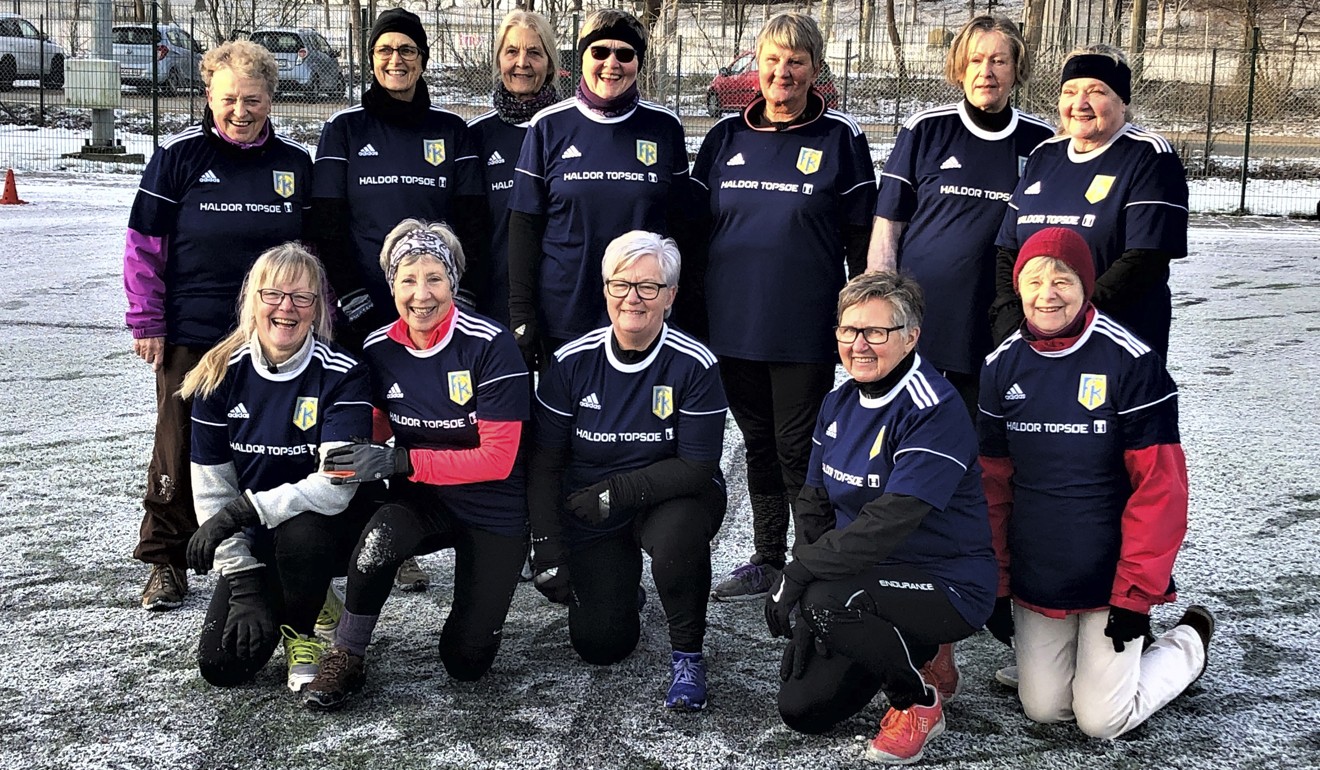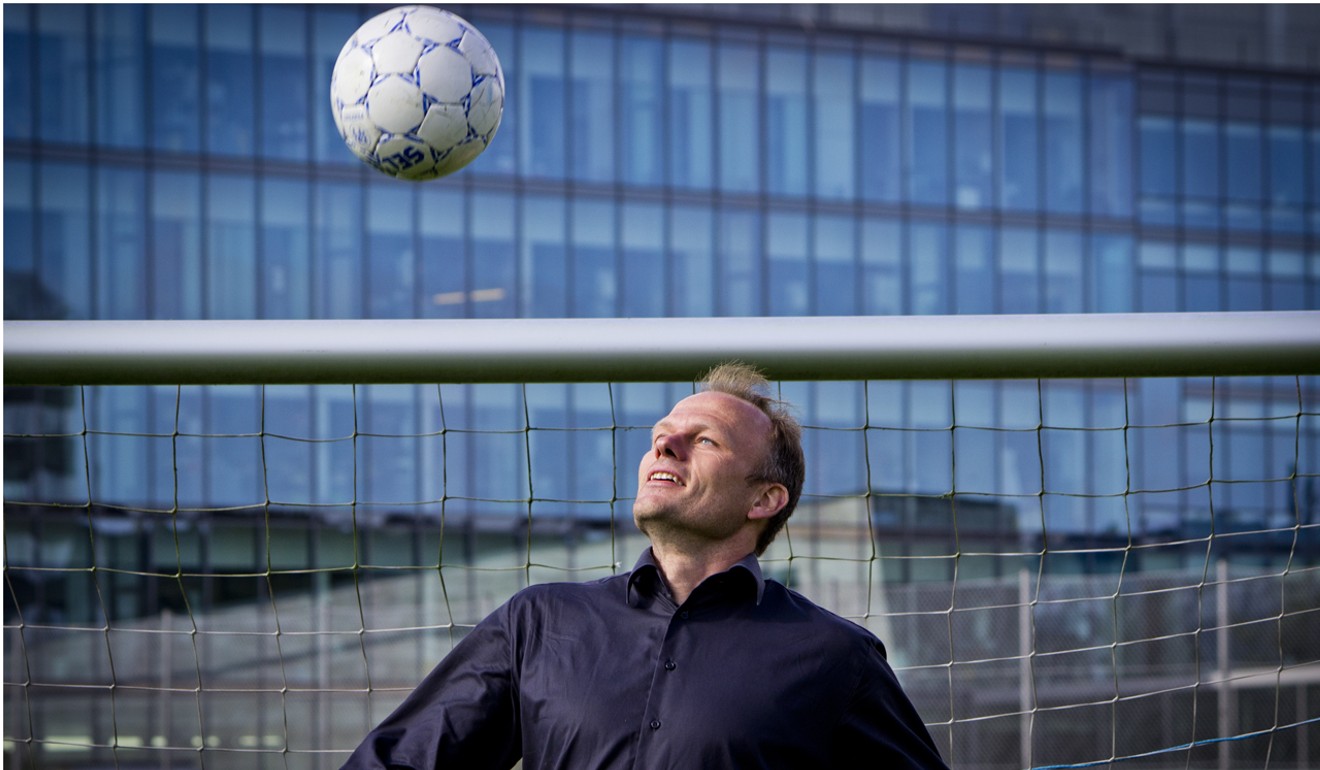
Football Fitness: the Danish grannies soccer team that’s part of a global health revolution
- The oldest player is 85, the youngest 55, there are no tackles and few rules – this is recreational soccer with a focus on fun, socialising and boosting health
- These grannies practise Football Fitness, a Danish sports concept that uses soccer training to promote physical activity and limit lifestyle diseases
In the Danish town of Frederikssund is a soccer club. It is, like many Danish clubs, the hub of a tight-knit community and, while it boasts several teams of all ages, one particular team has earned itself a place on the world map of sports science.
“Momseholdet”, or grannies team, consists of women above the age of 60. They meet every Thursday come rain or shine to practice Football Fitness, an all-Danish concept which is gaining a foothold in several countries around the world.
Soccer is the world’s most popular sport, with an estimated 500 million players worldwide, 300 million of which are registered in clubs. Sport and health sciences professor Peter Krustrup from the University of Southern Denmark in Odense borrowed key elements of the sport to invent Football Fitness in collaboration with the Danish Football Association.
Krustrup, who is also a visiting professor at Shanghai University of Sport and Beijing Sport University, has been researching soccer and health for 15 years. Studies have shown that Football Fitness can be used for the effective prevention and treatment of several lifestyle diseases, including cardiovascular disease and type 2 diabetes.

People of all ages and both sexes, with or without soccer experience, and regardless of their level of physical fitness can take part in Football Fitness, an intense and versatile form of training that combines endurance, aerobic high-intensity interval (HIIT) and strength training.
It begins with a thorough warm-up for strength and balance, and ball exercises, followed by different drills and games. Tackling is not permitted, and should a player fall, the game is interrupted until he or she gets up again. No competitive matches are played to keep the focus squarely on having fun, socialising and boosting health.
This results in few injuries, especially compared with the type of match-play soccer normally broadcast on television, and promotes lifelong participation. It brings participants great enjoyment, gives them moderate exercise and builds social relations, which all helps their mental and social well-being.
We don’t have free kicks, penalties or throw-ins, and the number of players is not that important, either
“We ran 31 different research studies with different population groups, and apart from the prevention of lifestyle diseases, we now know that Football Fitness strengthens the bones and muscles, improves the postural balance and shifts the composition of the body towards bigger muscles and less fat,” says Krustrup.
When 71-year old Aase Hansen was diagnosed with high blood pressure back in 2014, she was prescribed medicine to treat it. She had always led an active life, but the medicine drained her energy and made her feel depressed. When she stumbled upon a panel discussion with Krustrup on television about the benefits of Football Fitness, she decided to gather a group of women together to create a team and invited him to join their first session to teach them the basics. He is now a frequent visitor to the pitch and keen supporter of Momseholdet.
Since their first session in October 2014, the team has grown from seven to 34 women. Goalkeeper Gerda Lose is the oldest team member, aged 85. Marianne Hersted, aged 55, is the youngest. She was allowed to join before turning 60 as she was suffering from back problems and was convinced that Football Fitness would benefit her. The second youngest player is 63-year-old Mie Nygard, who has sclerosis.

Hansen loves that there are almost no rules. “We don’t have free kicks, penalties or throw-ins, and the number of players is not that important, either,” she says. “Last week, there were 17 of us and we split up into two teams, whereas the week before last, there were 25 of us so I divided the players into three teams of six players and one team of seven.”
The lack of rules ensures a greater flexibility and Football Fitness does not have to be played on a pitch. One of Hansen’s fondest memories is when she played with a group of immigrant women at the local park. “We had no goals and no lines but we had a blast.”
The grannies team receives strong support from their families and the local community. The soccer club opted not to charge them to use the pitch – as long as they promised to help out at its social events.
New gym model for China: HIIT for retirees, no mirrors and no loud music
Seniors have always been at the crux of Krustrup’s research. “It is important that we continue developing projects and knowledge-based concepts for the elderly segment,” he says. “Not only to promote physical activity and limit lifestyle diseases – but also to allow for seniors to thrive and to prevent loneliness.”
In 2016, Krustrup and his team won the National Danish Sport Award for FC Prostate, a concept that brings men with prostate cancer together on the soccer pitch to minimise side-effects of hormone treatment and, not least, to socialise. He has also established Football Fitness activities for breast cancer patients.
Football Fitness is currently practised at 325 Danish soccer clubs, a fifth of all the clubs in the country, and the national goal is for 10,000 more Danes to be practising it within three years. Pilot projects in the Faroe Islands, Norway, Serbia, the United Kingdom, Romania, and Brazil have produced positive results.
We don’t have free kicks, penalties or throw-ins, and the number of players is not that important, either
One of the big international clubs to have embraced the concept is Portuguese club FC Porto, which currently has 300 Football Fitness players. In China, research projects in Shanghai involving the elderly and diabetes patients are under way – as are projects with schoolchildren in Beijing.
The grannies team had their first official team outing in January this year and their bus was humming with excitement, song and laughter as it pulled up outside the University of Southern Denmark campus in Odense, the third largest city in Denmark. Team founder Hansen was invited to speak at the yearly “Football is Medicine” conference.
Her teammates were there not only to support her but also to give a demonstration to researchers from around the world who had come to present and discuss the increasing evidence to support recreational soccer as a tool for the prevention and treatment of various diseases.
In her speech, Hansen said that when she sat down a few years ago to write a list of the things she would like to do during the last chapter of her life, it did not mention soccer. Little did she know that it would become such a big part of her life – and that it would eventually allow her to ditch her conventional blood pressure medicine altogether.

The basis of using soccer as medicine
• A platform based on the “Football for Health” research was launched in 2003 and consists of observational pilot studies on movement patterns, exercise intensity and fitness benefits of soccer training.
• Professor Peter Krustrup and his team have published 140 research papers about soccer for health in more than 40 scientific journals.
• Investigations include Danish low-level senior and veteran players, homeless men and sedentary computer enthusiasts, the so-called FC Zulu team, with no prior soccer experience.
• Studies have shown that short-term soccer training is as effective as drugs against high blood pressure.
How Hong Kong seniors discover yoga and its benefits
• Football Fitness may be characterised as an all-in-one type of training with broad-spectrum fitness effects for the general population.
• Evidence suggests Football Fitness is an effective prevention, treatment and rehabilitation strategy for a broad range of patient groups.
• The first international Football is Medicine conference was held at the Cidade do Futebol complex in Portugal in January 2018.

